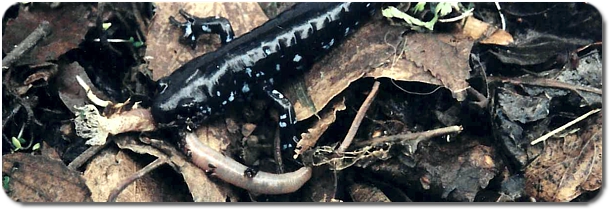Blue-spotted Salamander

What it looks like
The Blue-spotted Salamander is a small salamander. It is only about 10 to 12 cm long. The colour is shiny black with light blue spots on the sides. The belly is dark gray or black.
Look-alikes
The Blue-spotted Salamander has no look-alikes in Manitoba. Our other salamanders are much larger and are never solid black in colour.
Name
This salamander gets its common name from the light blue spots on its sides.
Scientific Name
The Blue-spotted Salamander's scientific name is Ambystoma laterale. Learn what that means on this page: Scientific Names.
Where it lives
Blue-spotted Salamanders live in forests where the ground is damp. They live in eastern North America. In Manitoba, they are only found in the southeastern part of our province.
Where Blue-spotted Salamanders live in North America.
Habits
Blue-spotted Salamanders are most active at night. They hunt for food under the leaves on the forest floor. They spend winter underground in the holes along tree roots, in caves or in animal burrows. They must go below where the frost can reach, but they can stay active below ground all winter.
Food Web
These salamanders eat worms, slugs, small insects and other small invertebrates. Salamander larvae eat insects and other tiny water animals that live in the ponds with them.

A Blue-spotted Salamander eating a worm.
Not many animals will eat Blue-spotted Salamanders because they taste bad. Snakes are probably their main enemies.
Life Cycle
Blue-spotted Salamanders breed in ponds that fill from melting snow or in small permanent ponds. They mate and lay eggs in April or early May. Females lay about 500 eggs, one at a time or in small bunches on sticks or plants in the pond. The eggs take about 30 days to hatch.
The larvae grow to be about 3 to 5 cm long by late July or early August. Then they lose their gills and change to their adult shape and colour.
Numbers
Blue-spotted Salamanders are very common in southeastern Manitoba, but no one knows how many can be in each hectare of forest.
Special Things
Blue-spotted Salamanders protect themselves by making a sticky bad-tasting liquid that squeezes out if they are attacked. They will also wiggle their tail to get a predator to bite the tail instead of its head or body. The animal gets a mouthful of yucky liquid and drops the salamander without hurting its head and body.
How to Find Blue-spotted Salamanders
In spring look for adults in ponds in southeastern Manitoba where Wood Frogs breed. Wood Frogs are the earliest of the frogs to breed and Blue-spotted Salamanders move to the ponds about the same time. At night with the aid of a flashlight they can be seen on the bottom of the pond. They will not be visible during the day.
For the rest of the summer and fall Blue-spotted Salamanders can occasionally be found in moist woodlands by looking under logs, rocks or debris left by humans.
Use by People
Blue-spotted Salamanders are very hard to find and most people have never seen one in the wild. They aren't used by people.
| Next: Gray Tiger Salamander | Back to: Amphibians and Reptiles Front Page |
For more on the Blue-spotted Salamander in NatureNorth.com follow this link:
